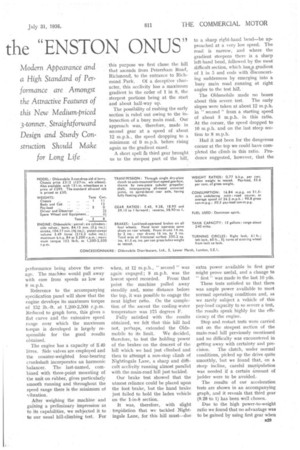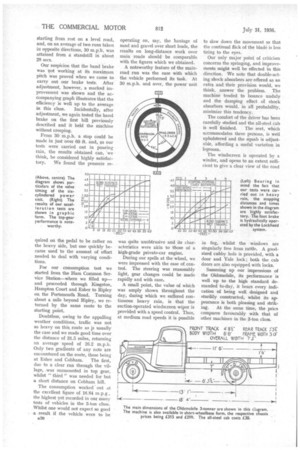THE OLDSMOBILE SATISFIES
Page 34

Page 35

Page 36

If you've noticed an error in this article please click here to report it so we can fix it.
the "ENSTON ON
Road Test No. 243
/N taking over for test a newcomer to the British market—the Oldsmobile 3-tonner—our mind was irresistibly drawn to the position of the newcomer to the haulage industry, and to the Enston onus, as laid down by the Appeal Tribunal. The analogy is particularly apt. A new carrier must show, prima facie, not only that there arc persons ready and willing to employ him, but that the work which he proposes to do cannot be performed by anyone else in the district.
To gain a firm footing in the market, an entirely new commercial vehicle must be able not only to carry out efficiently the work required from it by the average operator, but it must have, in one respect or another, outstanding char acteristics. The keen competition existing . among long-esitablished manufacturers compels this distinction.
With these facts in mind, we submitted the Oldsmobile to the " Enston " test. It proved that it would give satisfactory service under all normal operating conditions ; furthermore, in respect of general performance, the results were excellent. On the score of driver-comfort and appearance, the Oldsmobile takes high marks. Additionally, the; results of our 'consumption test Were superiorto thoSe -obtained With Most other vehicles in the 3Ltori class. '
Well known • in the 'private2car
Ei28 world, the Oldsmobile has gained a fine reputation, and the maker's experience in this field is reflected in certain noteworthy characteristics which • we observed when testing its latest product, designed, of course, for use in a very different sphere of action.
A feature, Common to the majority of vehicles of trans-Atlantic origin, is a high power-to-weight ratio, and' in this respect the Oldsmobile is no exception. The power output is 84 b.h.p. at 3,500 r.p.m. and, as tested by us with a load of 3 tons, this gives a power-weight ratio of
0.77 b.h.p. per cwt. Incidentally, this is the highest figure yet recorded in our road tests of machines in this class.
In view of the ample power available, we were interested to see whether the top-gear performance came up to our expectations. We soon found that the smoothness and flexibility of the power unit, combined with a well-chosen top gear ratio of 5.43 to 1, resulted in the performance being above the average. The machine would pull away with ease from speeds as low as 8 m.p.h.
Reference to the accompanying specification panel will show that the engine develops its maximum torque of 152 lb.-ft. at 1,200-2,500 r.p.m. Reduced to graph form, this gives a flat curve and the extensive speed range over which the maximum torque is developed is largely responsible for the good results obtained.
The engine has a capacity of 3..49 litres. Side valves are employed and the counter-weighted four-bearing crankshaft incorporates an harmonic balancer. The last-named, combined with three-point mounting of the unit on rubber, gives particularly smooth running and throughout the speed range there is the minimum of vibration.
After weighing the machine and gaining a preliminary impression as to its capabilities, we subjected it to to our usual hill-climbing test. For
this purpose we first chose the hill that ascends from Petersham Road, Richmond, to the entrance to Richmond Park. Of a deceptive character, this acclivity has a maximum gradient in the order of 1 in 8, the steepest portions being at the start and about half-way up.
The possibility of rushing the early section is ruled out owing to the intersection of a busy main road. Our approach was, therefore, made in second gear at a speed of about 12 m.p.h., the speed dropping to a minimum of 9 m.p.h. before rising again as the gradient eased.
A short spell Ian third gear brought us to the steepest part of the hill,
when, at 12 m.p.h., "second " was again engaged ; 8 m.p.h. was the lowest speed recorded. From that point the machine pulled away steadily and, some distance before the top, it was possible to engage the next higher ratio. On the completion of the ascent the cooling-water temperature was 175 degrees F.
Fully satisfied with the results obtained, we felt that this hill had not, perhaps, extended the Olds
mobile to its limit. We decided, therefore, to test the holding power of the brakes on the descent of the hill which we had just climbed and then to attempt a non-stop climb of Nightingale Lane, a sharp and difficult accliyity running almost parallel with the main-road hill just tackled.
Our brake test showed that the utmost reliance could be placed upon the foot brake, but the hand brake just failed to hold the laden vehicle on the 1-in-8 section.
It was, therefore, with slight trepidation that we tackled Nightingale Lane, for this hill must—due to a sharp right-hand bend—be approached at a very low speed. The road is narrow, and where the gradient steepens there is a sharp left-hand bend, followed by the most difficult section, which hasa. gradient of 1 in 5 and ends with disconcerting suddenness by emerging into a busy main road running at right angles to the test hill.
The Oldsmobile made no bones
about this severe test. The early slopes were taken at about 12 m.p.h. in " second " from a starting speed of about 5 m.p.h in this ratio. At the corner, the speed dropped to 10 m.p.h. and on the last steep seelion to 8 m.p.h.
Had it not been for the dangerous corner at the top we could have completed the climb in this ratio. Prudence suggested, however, that the
extra power available in first gear might prove useful, and a change to " first " was made in the last 10 yds.
These tests satisfied us that there was ample power available to meet normal operating conditions and, as we rarely subject a vehicle of this pay-load' capacity to so severe a test, the results speak highly for the efficiency of the engine.
Stop and restart tests were carried out on the steepest section of the main-road hill previously mentioned and no difficulty was encountered in getting away with certainty and pre
cision. The clutch, under normal conditions, picked up the drive quite smoothly, but we found that, on a steep incline, careful manipulation was needed if a certain amount of judder were to be avoided..
The results of our acceleration tests are shown in an accompanying graph, and it reveals that third gear (9.28 to 1) has been well chosen.
Due to the high power-to-weight ratio we found that no advantage was to be gained by using first gear when starting from rest on a level road, and, on an average of two runs taken in opposite directions, 30 m.p.h. was attained from a standstill in about 28 secs.
Our suspicion that the hand brake was not working at its maxiraum pitch was proved when we came to carry out our brake tests. After adjustment, however, a marked improvement was shown and the accompanying graph illustrates that the efficiency is well up to the average in this class. Incidentally, after adjustment, we again tested the hand brake on the first hill previously described and it held the Machine without creeping.
From 30 m.p.h. a stop could be made in. just over 60 ft. and, as our tests were carried out in pouring rain, the results obtained can, we think, be considered highly satisfac tory. We found the pressure re quired on the pedal to be rather on the heavy side, but one quickly became used to the amount of effort needed to deal with varying conditions.
For our consumption test we started from the Hans Common Service Station—where we filled upend proceeded through Kingston, Hampton Court and Esher to Ripley on the Portsmouth Road. Turning about a mile beyond Ripley, we returned by the same route to the starting point.
Doubtless, owing to the appalling weather conditions, traffic was not so heavy on this route as js usually the case and we made good time over the distance of 31.5 miles, returning an average speed of 26.2 m.p.h. Only two gradients of any note are encountered on the route, these being at Esher and Cobham. The first, due to a clear run through the village, was surmounted in top gear, whilst " third " was needed for but a short distance on Cobham hilt.
The consumption worked out at the excellent figure of 16.84 m.p.g., the highest yet recorded in our many tests of vehicles in the 3-ton class. Whilst one would not expect so good a result if the vehicle were to be a30 • operating on, say, the haulage of sand and gravel over short leads, the results on long-distance work over main roads should be comparable with the figures which we obtained.
A noteworthy feature of the mainroad run was the ease with which the vehicle performed its task. At 30 m.p.h. and over, the power unit was quite unobtrusive and its characteristics were akin to those of a high-grade private-car engine.
During our spells at the wheel, we were impressed with the ease of control. The steering was reasonably light, gear changes could be made rapidly and with ease.
A small point, the value of which was amply shown throughout the day, during which we suffered continuous heavy rain, is that the suction-operated windscreen wiper is provided with a speed control. Thus, at medium road speeds it is possible to slow down the movement so that the continual flick of the blade is less tiring to the eyes.
Our only major point of criticism concerns the springing, and improvements might well be effected in this direction. We note that double-acting shock absorbers are offered as an extra and their provision would, we think, answer the problem. The machine tended to bounce unduly and the damping effect a shock absorbers would, in all probability. minimize this tendency.
The comfort of the driver has been carefully studied and the all-steel cab is well finished. The seat, which accommodates three persons, is well upholstered and the squab is adjustable, affording a useful variation in legroom.
The windscreen is operated by a winder, and opens to an extent sufficient to give a clear view of the road
in fog, whilst the windows are singularly free from rattle. A goodsized cubby hole is provided, with a door and Yale lock ; both the cab doors are also equipped with locks.
Summing up our impressions of the Oldsmobile, its performance is well up to the high standard demanded to-day, it bears every indication of being well designed and sturdily constructed, whilst its appearance is both pleasing and strik ing. At the same time, the price compares favourably with that of other machines in the 3-ton class.












































































